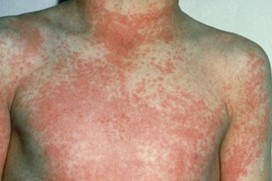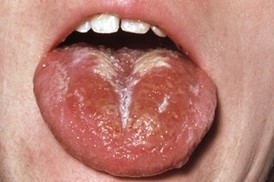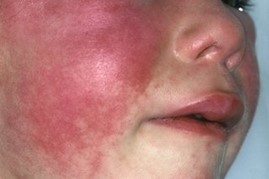Scarlet fever
What is scarlet fever?
Scarlet fever is one of a number of infections caused by the bacteria Streptococcus pyogenes, also known as group A streptococci (GAS).
What are the symptoms of scarlet fever?
Scarlet fever mainly affects children under 10 years of age.
Symptoms include:
- Fever (38 degrees Celsius or higher)
- Sore throat
- Rash
- Flushed cheeks
- Swollen neck glands
- Swollen tongue
The rash normally appears 12 to 48 hours after the fever and sore throat. It is red and looks like small, raised bumps and it feels rough to touch like sandpaper. It typically starts on the face, chest, or stomach and then spreads. The face may appear red like sunburn which a pale ring around the mouth. Folds of skin around joints, the neck, and the groin can be a deeper red.
The tongue can develop a white coating early on which then peels to leave the tongue red and swollen. It is often described as ‘strawberry tongue’.



Source: Scarlet fever - HSE.ie
What are the complications of scarlet fever?
Scarlet fever is usually a mild infection without any complications. However, complications such as ear infection, throat abscess, and pneumonia can occur. Very rarely, more severe complications leading to kidney or heart damage can occur. Prompt treatment with antibiotics will prevent these complications.
How is scarlet fever spread?
Scarlet fever is spread by contact with secretions from an infected person’s nose or mouth through sneezing, coughing, or direct contact with secretions (e.g. kissing, wiping noses, sharing utensils, or from a wound). After infection it takes between two and four days to develop symptoms. A person can still spread the scarlet fever even if they don’t feel unwell or have any symptoms.
When to see a doctor?
Your child should be taken to your GP if they have symptoms of scarlet fever, or also have chickenpox at the same time. They should also be taken to the doctor if they are ill again a few weeks after the scarlet fever got better, which can be a sign of a complication, or if they are a close contact of someone with scarlet fever.
Any signs of breathing difficulty require emergency evaluation. This includes shortness of breath at rest, noisy breathing, rapid breathing, nostril flaring, and pulling in chest-muscles between the ribs. Other emergency symptoms are chest pain, inability to swallow liquids, muffled voice, confusion, inability to stay alert, dizziness, persistent or severe vomiting and diarrhoea, and dehydration.
How is scarlet fever diagnosed and treated?
Healthcare professionals will often be able to diagnose scarlet fever based on the symptoms alone. Sometimes a throat swab to test for the bacteria or a blood sample will be required. If diagnosed, it is treated with a 10-day course of antibiotics. It is important to take the full 10-days of antibiotic treatment, even if you feel better, as this will reduce the risk of complications and spreading the infection to others.
Without treatment, a person can be infectious and spread the infection to others for a few weeks. However, after 24 hours of antibiotics, a person will not be infectious. Those diagnosed with scarlet fever should not attend crèche, school, or work until at least 24 hours after starting antibiotics to avoid spreading the infection.
Other ways to prevent spreading infection includes frequently washing hands (especially after contact with secretions or before preparing food), using tissues to trap germs from coughs or sneezes, binning used tissues as quickly as possible, not sharing utensils or bedding with an infected person, and washing utensils in in hot soapy water.
Data from the UK over a 4-year period also suggests that the nasal flu vaccine may reduce GAS infections in children.
What is group A streptococci (GAS)?
The GAS bacteria which causes scarlet fever is a common bacteria which often lives on people’s skin and in their throat. For most people, the bacteria do not cause any problems. However, occasionally they cause diseases such as scarlet fever, sore throat (“strep throat”), and skin infections like impetigo. Rarely, the GAS bacteria can become invasive and cause more severe, sometimes life-threatening, infections. This is known as invasive GAS (iGAS) disease and occurs when the bacteria get into parts of the body where it shouldn’t be found, such as the lungs or bloodstream. iGAS can cause streptococcal toxic shock syndrome, necrotising fasciitis, and sepsis.
Scarlet fever and the other milder infections caused by GAS bacteria are not notifiable in Ireland meaning that healthcare professional do not have to report cases to the national surveillance centre. Because of this the number of cases in Ireland is not known. In England, there were 58,972 notified cases of scarlet fever between September 2022 and June 2023.
More severe, iGAS diseases are notifiable in Ireland. As of June 2023, there has been an increase in notified iGAS infections in Ireland since October 2022, with data from 2023 suggesting that it continues to remain at a higher level than expected.
Further information on GAS infections in Ireland is available at HPSC.ie and HSE.ie.
Last updated: 19 October 2023


